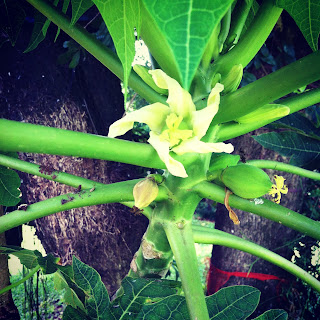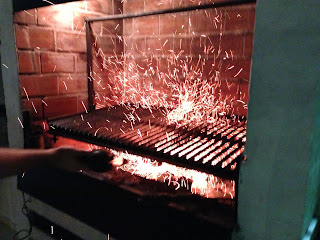Thursday, February 28, 2013
Fatties:)
Whenever return home to California, I let loose.
Mmm Concha
Avocado Harvest
What better way to celebrate not being in frigid New York than to harvest avocados from my Mary's tree.
Courtney and I found this harvesting tool near the garage.
Our avocado bounty:)
Sunday, February 17, 2013
Yerba Maté
Yerba Maté is tea consumed on a daily basis by almost all Paraguayans. The yerba maté plant is native to Paraguay. I like to compare it to a cross between Green tea and Oolong or Lapsang Souchong. It has certain smokiness about it, but also maintains a very herbal freshness at the same time. Depending on the time of year, Paraguayans travel with a thermos of hot or cold water, a maté(cup) and a bombilla (silver straw). The tea can be served hot (maté) or cold (tereré). It can blended with lemon and herbs like mint or served sweetened with milk (maté cocido).
Drinking maté is often a communal activity. When you are with friends a communal maté vessel is passed around and shared.
La Bombilla - a straw made from silver with a strainer attached to the tip to separate out the maté pulp as you sip.
I keep my yerba maté in a glass jar. It takes anywhere from a 1/2 cup to full cup of ground mate leaves to fill your vessel. The bombilla is then pushed into the mate leaves. Water is then poured into the vessel. The water is left to stand for a minute or two. The first sip of mate is really bitter. You pour off the water the first and second times you fill the vessel, but by the third filling your maté is ready!
My maté cup (called a maté) is made from fragrant palo santo wood. Palo Santo wood is one of the hardest woods found in the world. The maté can be found in many forms including the guampa (bull's horn) or calabaza (gourd). They are often accented with leather.Friday, February 1, 2013
Frutas y Otro Comida de Paraguay
Banana Flower
Ani harvesting mangoes from the tree in his backyard.
Mangoes are so abundant in Paraguay the are not sold in the supermarket / grocery. Almost every home has at least one mango tree. They are popular not only for the fruit they produce, but the cool dense shade they provide as the tree matures. An adult mango tree can produce hundreds of mangoes.
The sap that bleeds out of the stem of a freshly picked mango has the most delicious smell. It is very sticky and mildly toxic.
The blossom of a papaya and a baby papaya.
Ani harvesting papayas from the tree in his backyard. Shaking the trunk is the most effective way to harvest a papaya.You can buy eight pineapples for the roughly US$5 in Ciudad del Este.
Fresh papaya for breakfast and two types of mango juice.
The yerba mate aisle in the supermarket. Yerba is consumed on daily basis by everyone in Paraguay, especially in the summer. I will have a later post devoted to Yerba:)
I rarely drink soft drinks in the States, however I couldn't resist the urge to taste something familiar after day eight while in the airport. Paraguyan Coca-Cola is made with cane sugar and is super tasty.Yeyi told me a tale she heard about someone giving beet juice to an alcoholic to trick them out of their alcoholism. If they ask for a drink you give them beet juice and tell them it is wine, they are too drunk to know the difference:)
Jesus making pan like a pro.
Jesus and Yeyi The pan before it is baked.
 All Paraguayan homes have a parilla (an outdoor wood burning grill encased in brick on three sides) The parilla has a rack that is attached to a frame with a built in cranking mechanism. If your fire is too strong you can raise the meat filled rack away from the flame.
All Paraguayan homes have a parilla (an outdoor wood burning grill encased in brick on three sides) The parilla has a rack that is attached to a frame with a built in cranking mechanism. If your fire is too strong you can raise the meat filled rack away from the flame.Leg of lamb, pork ribs and an assortment of paraguayan sausages.
Subscribe to:
Comments (Atom)
















































